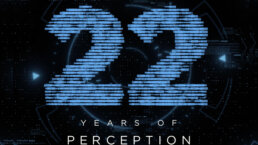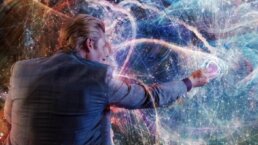The future of automotive is a thrilling topic. For years, we have been seeing flying cars and self driving vehicles present in science fiction media, with the latter slowly becoming part of our current reality. While cars aren’t taking to the skies just yet, they are becoming more complex and advanced with every new make and model that hits the market.
At Perception, we have collaborated with automotive brands across the globe to help bring their vehicles into the future. It’s our goal to elevate the user experience of a vehicle to transform what it means to drive a car. We do so by designing the digital aspects of the instrument cluster and center stacks. We’re tasked with bringing our futuristic touch to these features and making these areas of the vehicle an entirely upgraded experience.
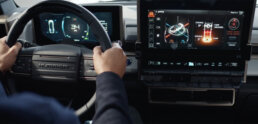
As we work on these digital displays, we’re always mindful of one question – how far is too far? It’s easy to suggest flashing displays with intricate typography and a ton of tiny, moving details, akin to what we traditionally think of as “futuristic”. For a film, that could work! But for automotive, it’s less about the look and more about the function.
Part of our job within the automotive industry is to push as far as we can with our designs, and then fine tune everything to fit within the realm of practicality. It’s a push and pull between form and function, where we try to make something usable and practical while aesthetically taking everything a step further. For aesthetics, we love looking at our client’s branding, the history of that vehicle and how it can evolve in the future. When we nail that down, we begin focusing on practicality and, the most critical aspect, safety.
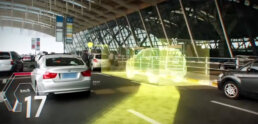
Safety is of the upmost importance in the automotive industry. There are regulations and guidelines we follow about type size and the amount of information than can be present on the screen. Data should be instantly readable and present on these displays so the driver doesn’t get distracted or spends too long with their eyes off the road to search for the information they need.
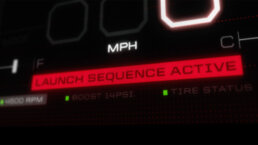
This is where I find there is a restriction within digital displays. When working on a vehicle, I always like to ask, “how can we bring back the physical elements of an automotive interface?”. In most new vehicles, everything that the driver touches is digital. There is no physical feedback and because of that, the driver may need to take their eyes off of the road to confirm that they have actually hit the “button” or portion of the screen they intended to interact with.
But there is a solution to that – touch. Our team is always focusing on how our work can utilize the five senses to enhance a user’s experience. For automotive, one of those key senses is touch.
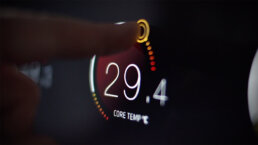
A marriage between physical buttons and displays with digital interfaces can be crucial for projecting the automotive industry into the future. It could be as simple as a vibration or a indented press when the driver touches a part of the screen. But that element of touching and feeling a button, receiving that feedback and ensuring that you hit the correct option based on that feedback allows the driver to not need to search the displays, keeping their eyes on the road and promising safety.
Touch can be brought to the vehicle beyond its displays. Subtle haptics can be extremely beneficial. It wouldn’t cause any shock to the driver when activated while providing enough feedback to signal a change or interaction. Perhaps muted haptics of the steering wheel could indicate whether your vehicle is slowing down or speeding up, or the subdued vibrational click of a knob could increase or decrease based on your adjustment of your music’s volume.
Taking an even further step into the future, vehicles could include advanced haptics where the driver can feel where functions in the vehicles are using midair haptics. It’s a futuristic touch with a practical function – safety and control of the vehicle with an enhanced flare that sets that vehicle apart from the rest.
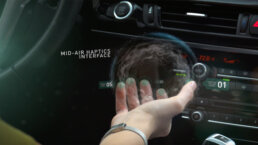
As we move into the future, vehicles are going to move with us. Maybe even one day, the entire industrial structure of a vehicle could change (and I’d love to see that!). But even as vehicles evolve, our team is always mindful that humans are at the core of this experience and we need feedback to confirm that we’re operating the vehicle safely and efficiently.
A futuristic flare isn’t always about being flashy with holograms and complex interfaces. For me, futuristic is developing innovative ways to immerse the user in a new, unparalleled experience. Integrating unique haptics and tactical based elements is a simple yet powerful way to progress the automotive industry into the future.
Doug Appleton
Doug Appleton is Perception’s resident VFX wizard. Formally taught in the world of motion graphics, Doug’s first job out of college was at Perception. He has been with the studio ever since.
Doug has grown with the team from their early days and has continued to flourish up the hierarchy as he learns and masters the intricacies of the film and technology worlds. His skill in successfully executing a diverse array of projects in the world of motion is matched only by his curiosity of the technology itself.
Doug’s projects have ranged from detailed UX interface projects for high profile security clients, to lead animator on title sequences for Avengers: Age of Ultron. As a director he often works with his team and clients to problem solve as a unit, encouraging collaboration and confidence.
In addition to VFX guru, Doug is also Perception’s resident Marvel database. A huge fan of the series and of exploring the unknown, Doug likes to collect memorabilia from all major projects, with the love and support of his wife and two feline friends. He is also known as “The Encyclopedia”.
